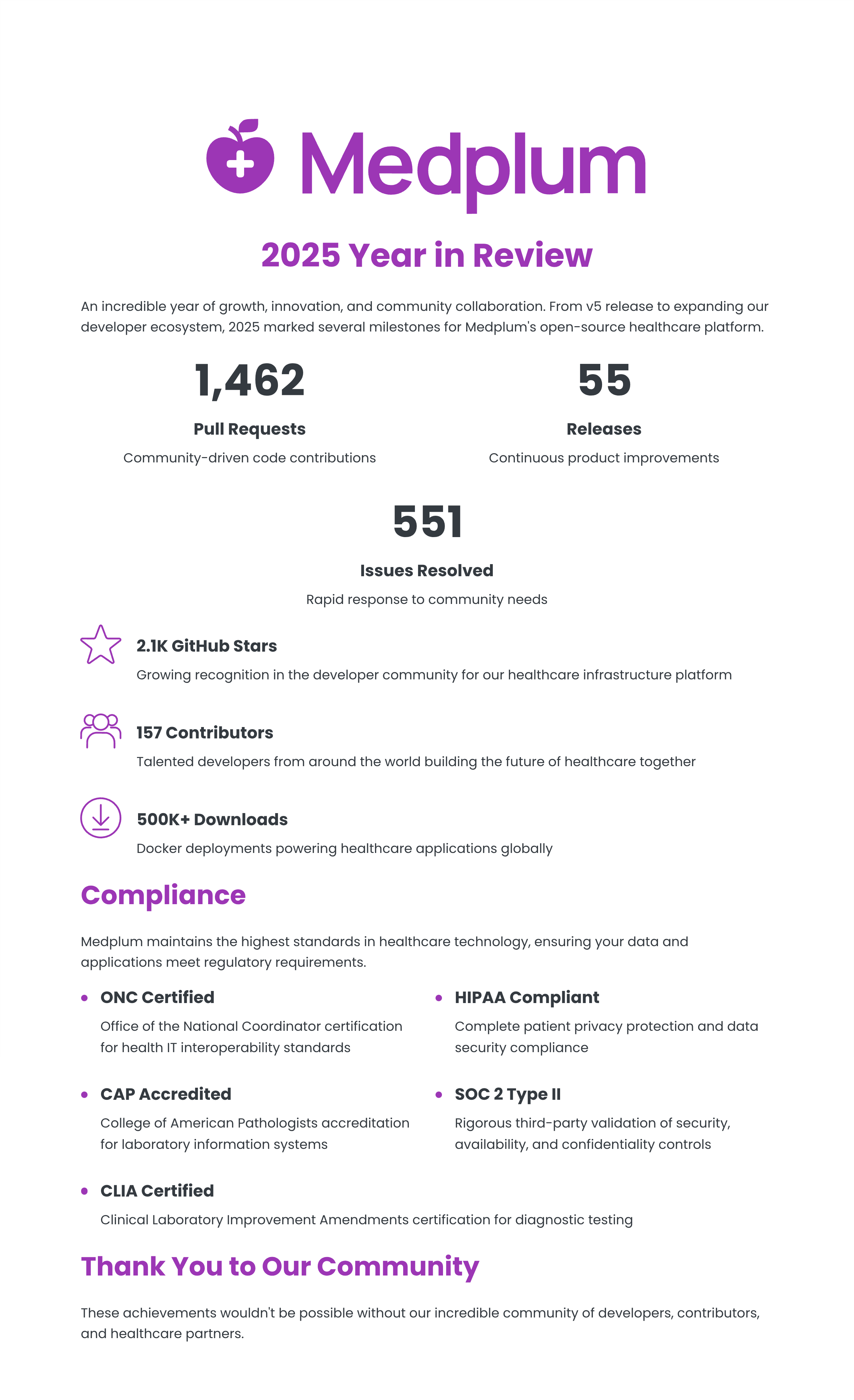Medplum Year in Review 2025

An incredible year of growth, innovation, and community. From v5 release to expanding our developer ecosystem, 2025 marked several milestones for Medplum's open-source healthcare platform.

An incredible year of growth, innovation, and community. From v5 release to expanding our developer ecosystem, 2025 marked several milestones for Medplum's open-source healthcare platform.
As part of the Medplum v5 release, we've been hard at work delivering several key improvements to our FHIR Terminology Services, which power Medplum's rich features for handling coded values:
ValueSet/$expand, allowing users to find codes by a number of different search termsConceptMap/$translate operation to handle maps with over a million entriesBelow we'll discuss each of these changes in more detail and give examples of the features available in Medplum's Terminology Services today.
Slideshow: View Presentation
This is a transcript summary of the October 2025 webinar with Medplum and Unity AI. Medplum CEO Reshma Khilnani interviews Unity AI CTO Cody Hall.
Reshma: We recently hosted a webinar exploring the intersection of AI, healthcare operations, and open-source infrastructure. I was joined by Cody Hall, CTO and Co-Founder of Unity AI, to discuss how his team is solving one of healthcare's most persistent bottlenecks: scheduling, using AI Agents.
We are pleased to announce the Release of Medplum v5, the next major version of the open source healthcare developer platform.
As outlined in our preparatory post in May, Medplum v5 represents a comprehensive and necessary modernization of our core stack. This release ensures our platform maintains the highest standards of performance, security, and developer experience by aligning with the latest stable versions of our critical runtime and tooling dependencies.
We're excited to share a new open-source project from the community that addresses a common developer challenge: integrating with legacy healthcare systems. HealthChain, an open-source Python framework, makes it easier to connect AI/ML pipelines to healthcare systems.
This project is a perfect example of how the open-source community is tackling real-world problems. It was created by Jennifer Jiang-Kells, an honorary researcher at the University College London Hospitals (UCLH) NHS Foundation Trust, highlighting its roots in a premier healthcare institution.
Hello everyone,
Thank you so much for joining us today for our FHIR and AI for Life Sciences webinar. It was great to see many familiar and new faces from the broader healthcare community.
We wanted to share the recording for anyone who missed it or who would like to check it out again!
| When | Topic | Location | Featuring |
|---|---|---|---|
| Jan 12, 2026, 4:00 PM - 7:00 PM PT | New Year, New Regs - In Depth on HTI-4 and HTI-5 with Brendan Keeler and Medplum | Medplum, SF |   |
| Jan 15, 2025, 9:00 AM - 2:00 PM PT | Interactive Workshop FHIR+AI for Life Sciences | Medplum, SF |   |
At Medplum, our mission is to provide the open source developer platform for healthcare. We believe that open source is the best way to build secure and interoperable healthcare applications. However, with the rising concern over software supply chain attacks, we understand that being "open source" isn't enough; we need to actively prove our commitment to security.
That's why a few months ago, we decided to ramp up our participation in the Open Source Security Foundation (OpenSSF). We're excited to share the progress we've made in two of their key programs: the Best Practices Badge and the Scorecard.
On August 28, 2025 Medplum hosted our first annual developer conference PlumCon in San Francisco. Thank you to everyone who attended and made this inaugural event such a success!
Below you'll find slideshows and videos from each presentation, organized by talk. Most sections includes the speakers presentation and slides. We also have a YouTube Playlist available.
We also want to thank everyone who donated demos and demo videos to this event - we are thankful for our community.
Medplum has become one of the first platforms to achieve certification for the Hub role in the Integrated Reporting Applications (IRA) IHE Profile, marking a milestone in radiology workflow interoperability. This certification positions Medplum as a central orchestrator for real-time synchronization between radiology applications, addressing one of healthcare's most persistent challenges: fragmented diagnostic workflows.
The IRA profile, published in October 2023 by Integrating the Healthcare Enterprise (IHE), represents a transformative approach to radiology interoperability. Built on FHIRcast 3.0.0 and FHIR R5 standards, IRA enables different applications—from PACS systems to AI tools—to share context and content seamlessly during diagnostic reporting. For Medplum, certification as a FHIRcast Hub means our platform can now coordinate complex radiology workflows where multiple applications must work together in harmony.